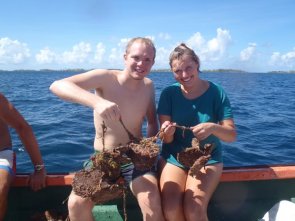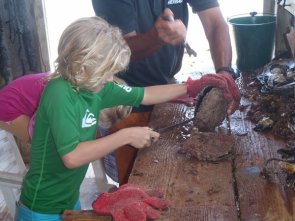Tonight's dinner was industrial waste

Anastasia
Phil May and Andrea Twigg
Sun 15 Apr 2012 07:46
|
It is not often you can eat the byproduct of an
industry, but tonight we ate oyster that would otherwise have been thrown to the
fish. Pearl oysters are bigger than eating oysters and have muscles that
are similar to scallops. A bit tougher than scallops, but more tender than
clams, they make excellent eating and the good bit is that we have another
meal's worth still in the freezer.
On our trip this morning our first stop
was to see how they collect the baby oysters. The process involves
floating long lines over the natural breeding beds. The baby oysters
swim upwards and attach to the lines, where they grow and are collected and
seeded. It sounds a bit hit and miss, but anyone who has had a boat in the
tropics knows how quickly shellfish will attach to anything floating near the
surface.
The seeded oysters are tied back on lines and left
for 18 months to develop their pearls. These first generation pearls
are harvested and the oysters are re-seeded. First generation pearls are
often flawed due to the trauma of the young oyster having the seed
inserted. However, oysters can be seeded multiple times, and the
second, third and fourth generation pearls are usually much higher quality due
to the hosts accepting the seed much more readily.
|




